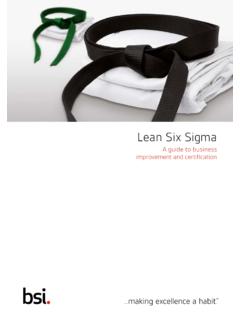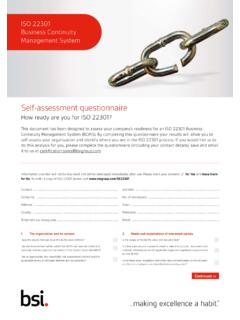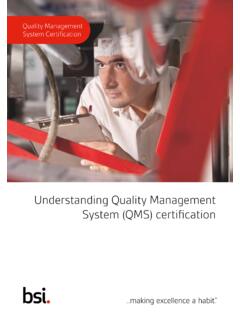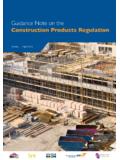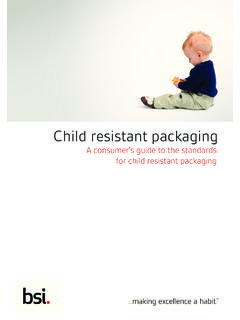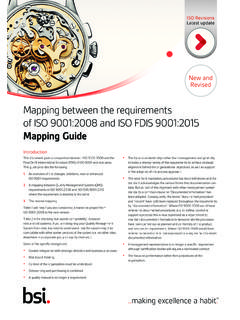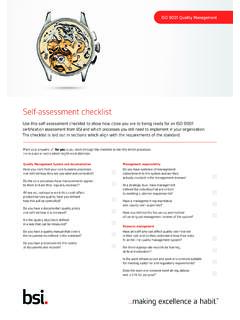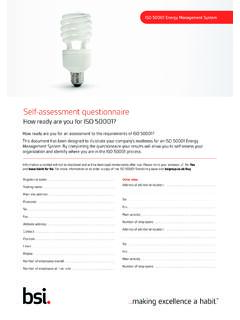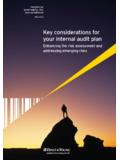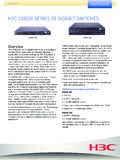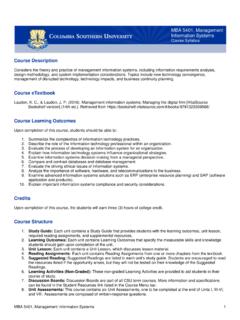Transcription of Moving from BS 25999-2 to ISO 22301 - BSI Group
1 Extract from The Route Map to business continuity Management: Meeting the Requirements of ISO 22301 by John SharpTransition GuideThe new international standard for business continuity management systemsMoving from BS 25999 -2 to ISO 22301 Successful businesses expect the unexpected and plan for it. Disruptions to your business can result in data risk, revenue loss, failure to deliver services as normal or in extreme cases, failure to deliver at s why organizations need strong business continuity planning. This guide has been designed to help you meet the requirements of the new international standard for business continuity management, ISO 22301 . ISO 22301 will supersede the original british standard, BS 25999 -2 and builds on the success and fundamentals of this ISO 22301 specifies the requirements for setting up and managing an effective business continuity management system (BCMS) for any organization, regardless of type or size.
2 BSI recommends that every business has a system in place to avoid excessive downtime and reduced productivity in the event of an the requirements of the new international standard has never been easier. This guide is an extract from John Sharp s latest book The route map to business continuity management and shares practical guidance on how to meet the requirements of ISO 22301 . The book is available through the BSI transition guide will help you understand your organization s needs and obligations and how to implement an effective BCMS. Whether you are planning to certify against the new standard or simply want to benefit from BCM best practice, this guide will help you put in place the necessary : This transition guide is designed to be read in conjunction with BS ISO 22301 : 2012 Societal security business continuity management systems Requirements.
3 It does not contain the complete content of the standard and should not be regarded as a primary source of reference in place of the standard adopt a business continuity standard?As business continuity management (BCM) has developed worldwide, there has been a convergence in the methodologies being promoted. It became apparent following the Year 2000 problem or millennium bug , when organizations were deluged with requests for compliance statements from their customers and clients, that there was a need for a uniform approach to is undesirable for major customers to enforce their own approach to BCM down their supply chains, as happened with other management systems, notably quality. While a supplier can run different quality systems to meet the requirements of its customer base, it cannot run different, and possibly conflicting, BCM systems, which will be used during a disruption at a time when tensions are high.
4 This was one of the principal drivers for establishing BCM standards in the 25999 was created to set out a uniform benchmark in good practice, satisfying the needs of customers, clients, government, regulators and all other interested parties. BS 25999 has been accepted worldwide and has formed the basis of many other BCM standards, including the US ASIS/BSI standard adopted by ANSI. BS 25999 and other BCM standards from across the globe provided the source material for the creation of two new international standards: ISO 22301 (requirements) and ISO 22313 (guidance).By adopting a standard approach to BCM as set out in ISO 22301 , organizations can offer their customers and clients greater assurance that they will be capable of maintaining continuity of operations if they suffer disruptive those already certified to BS 25999 -2 there will be a transition period to allow them to update their BCM systems to ISO 22301 .
5 For those certified, and those organizations working towards certification, the additional requirements are not ISO 22301 The international standard for BCM, ISO 22301 :2012 specifies requirements for setting up and managing an effective business continuity management system (BCMS). It is for use by internal and external parties, including certification bodies, to assess the organization s ability to meet regulatory and customer requirements as well as the organization s own requirements. ISO 22301 contains only those requirements that can be objectively audited and a demonstration of successful implementation can therefore be used by an organization to assure interested parties that an appropriate BCMS is in the latter part of 2012 or early in 2013, ISO will issue a guidance document ISO 22313.
6 This document will take the form of good practice guidance and recommendations, indicating what practices an organization should, or may, undertake to implement effective BCM. Organizations may choose to follow all or part of the guidance, which may be used for self-assessment or between organizations. The guidance is not a specification for ISO 22301 :2012 with BS 25999 -2:2007 When news of an ISO standard for BCM emerged, business continuity managers expressed concern that they might have to radically rework their BCM procedures and processes once ISO 22301 was introduced. BS 25999 -2 had been, and continues to be, used by many organizations across the world as the basis of their BCM procedures and processes. The good news is that BS 25999 -2 has provided the main foundation of the new ISO standard.
7 There are some important additions and a few elements that have been omitted. The additions have added greater depth and clarity while the omissions do not detract from the overall good BCM practices and new standard is entitled Societal security business continuity management systems Requirements. This is one of a suite of standards being developed by ISO/TC 223 designed to achieve greater societal security. Societal security can be defined as providing protection of society from, and the ability to respond to, incidents, emergencies and disasters caused by intentional and unintentional human acts, natural hazards, and technical way in which ISO 22301 can be used is detailed in Clause 1 Scope. It states that the standard is applicable to all types and sizes of organizations that wish to establish, implement, maintain and improve a BCMS ensure conformity with stated business continuity policy demonstrate conformity to others seek certification/registration of its BCMS by an accredited third party certification body make a self-determination and self-declaration of conformity with this International Standard [ISO 22301 :2012].
8 The standard can also be used by an organization to assess its suppliers ability to meet continuity needs and concepts and activities have been introduced as Concept ExplanationContext of the organization The environment in which the organization parties Replaces stakeholders .Leadership Requirements specific to top Acceptable Outage (MAO) Time it would take for adverse impacts, which might arise as a result of not providing a product/service or performing an activity, to become unacceptable . This is the same as maximum tolerable period of disruption (MTPD) .Minimum business continuity Minimum level of services and/or products that is acceptable Objective (MBCO) to the organization to achieve its business objectives during a disruption Performance evaluation Covers the measurement of BCMS and BCM timeframes Order and timing of recovery for critical and communication Activities undertaken during an have been many other additions and some slight alterations to the terms and definitions listed in the standard.
9 The additions and changes reflect terms and definitions commonly used by BCM practitioners major additions to ISO 22301 :2012 Clause 4: Context of the organizationThis clause introduces requirements necessary to establish the context of the BCMS as it applies to the organization, as well as needs, requirements and scope. ISO 22301 requires an organization to determine external and internal issues that are relevant to its purpose and that affect its ability to achieve the expected outcomes of its BCMS . Understanding the organization and how it sits within its environment is an essential step to ensure any BCMS and BCM solutions developed are fit for purpose and relevant to the organization and interested clause also requires the organization to determine its risk appetite and the legal and regulatory requirements that apply to the organization, and to clearly define the scope of the BCMS.
10 Setting the initial scope of the BCMS is critical and must be done at an early stage. ISO 22301 requires the organization to determine what will be covered by business continuity and, just as importantly, what will be excluded. Scoping has presented challenges to many organizations seeking certification under BS 25999 -2. Organizations are now required to clearly communicate the scope to relevant internal and external 5: LeadershipClause 5 summarizes the requirements specific to top management s role in the BCMS, and how they shall articulate their expectations to the organization via a policy requirements are placed upon top management to demonstrate its commitment by: ensuring the BCMS is compatible with the strategic direction of the organization integrating the BCMS requirements into the organization s business processes communicating the importance of effective business continuity management and conforming to the BCMS requirementsIn addition it must ensure that the BCMS achieves its expected outcomes and that it directs and supports continual creation and communication is an important element of Clause 5.
